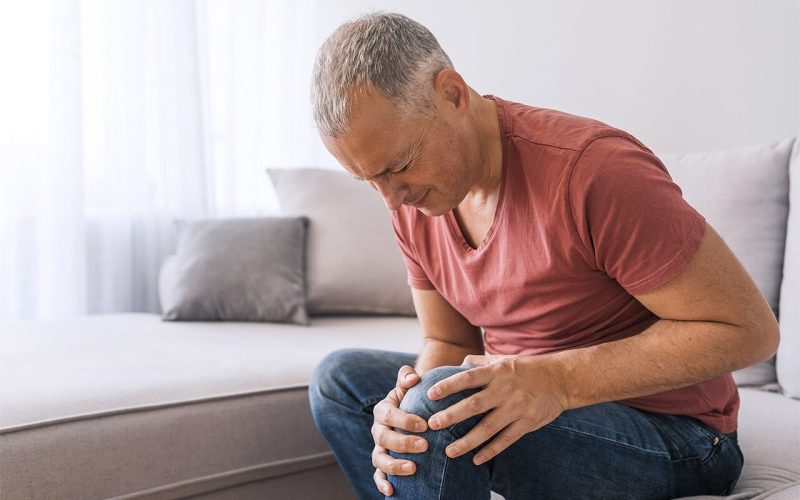Chronic pain almost invisibly affects one in five people. This surpasses the prevalence of cancer, heart disease, and diabetes combined. Compared to its huge worldwide societal impact relatively little research is dedicated to it. Niels Eijkelkamp PhD, associate professor at the Center for Translational Immunology at the UMC Utrecht, leads a research group that delves into the interaction between the immune system and the neurology of pain, with a particular focus on chronic pain.
Traditionally, pain is directly associated with the nervous system. However, recent insights show that the immune system is also involved in regulation and underlying causes of chronic pain. The nervous and immune systems communicate with each other, more broadly, but also within the context of pain. This discovery opens new perspectives, including the possibility of targeting the immune system in the treatment of chronic pain. “For years, effective pain medication has been sought, often without success, because the focus was primarily on the nervous system and reducing pain. The real breakthrough might lie in applying immunotherapy,” Niels Eijkelkamp explains. This approach shifts the focus from symptom reduction, as is currently common, to addressing the underlying cause(s) of chronic pain.
The immune system and pain
How did this insight come about? “As soon as I started working in research, I was hooked on the complexity of chronic pain. Only more recently we found that the immune system plays an intriguing role in regulating pain. It all started with the observation of immune cells near neurons. Initially we were surprised to find immune cells near neurons, which led to subsequent research.” Niels responds. Currently, this field is steadily developing and revealing more about the interactions between immune cells and neurons and how these can contribute to the development of chronic pain. It turns out that the immune system plays an active role in reducing pain after the inflammation is gone. Niels Eijkelkamp and his team are exploring the hypothesis that chronic pain may arise from a malfunctioning ‘off-switch’ in the immune system. The immune system elicits an inflammatory response after tissue damage or when the body encounters intruders. Part of this process is signalling to the nervous system to induce pain. Originally, researchers assumed that pain would passively resolve when the inflammatory signals would dissipate. However, with this new hypothesis, the immune system may need to actively switch off pain to reset pain perception. When this process malfunctions, pain can become chronic and remains far after the initial trigger has gone.
“As soon as I started working in research, I was hooked on the complexity of chronic pain. Only more recently we found that the immune system plays an intriguing role in regulating pain.”
How to switch-off pain
Central to this innovative view is the role of macrophages in pain regulation, specifically the M2-like phenotype. Macrophages are known for their plasticity and ability to adopt different functional states, from pro-inflammatory (M1-like) to anti-inflammatory (M2-like), in response to various signals within the body. Niels’ research team has uncovered that M2-like macrophages accumulate around sensory neurons in the dorsal root ganglia, the sites where the cell bodies of pain sensory neurons are situated. These macrophages facilitate pain resolution by donating mitochondria (powerhouses of the cell) to sensory neurons, thereby helping to ‘turn off’ chronic pain signals. This mechanism of mitochondrial energy donation not only highlights the active role of the immune system in managing pain but also opens up new insights into understanding and treating chronic pain. “The first step towards improving the lives of chronic pain patients would be to focus research on understanding the underlying mechanisms of chronic pain and finding ways to resolve these disruptions. In our research, we explore not only the involvement of the immune system but also the impact of cellular energy management within this process,” Niels explains.
Ongoing research: Laboratory and cohorts
The team’s research into the underlying mechanisms of chronic pain uses a variety of research methods, ranging from fundamental laboratory research to following patient cohorts and developing new therapies. In the laboratory, the focus is on fundamental research into the interactions between neurons and immune cells. “We do this both in vitro, by culturing neurons and adding immune cells to observe their response, and through animal experiments,” Niels explains. “In mouse models, inflammatory pain signals are mimicked with substances that induce inflammation and activate neurons, to analyze how these signals affect immune cells withing the nervous system and how sensory neurons manage their energy. Animal research plays a crucial role in unravelling the complexity of pain because we still do not fully understand which cell, neuronal networks and tissue interact which each other in pain. Although we remain critical of its necessity, such studies have enabled us to identify molecules that we never would have discovered otherwise. On the other hand, we put quite some effort in developing models that do not use animals.”
“The fact that everyone has experienced inflammation or tissue damage at some point in their lives, and the majority readily resolves from this pain, offers a unique opportunity to learn from this normal process and that will help us to understand what may go awry when pain becomes chronic. By understanding what which mechanisms contribute to resolution of pain and prevent people from developing chronic pain, we may be able to mimic or boost these mechanisms that lead to recovery in chronic pain patients,” Niels highlights. Therefore, the research group is looking at the cellular processes that turn off pain where this process fails. Ultimately, through active collaboration with other academic partner, industry and UMC Utrecht spin-off company Synerkine Pharma, they are looking for therapeutic molecules with curative potential that can mimic the process of switching off pain, instead of only dampening pain symptoms that currently available treatment options do (e.g. opioids).
Integrating clinical studies: from bench to bedside
Anesthesiologist and pain specialist Mienke Rijsdijk, MD, PhD from the UMC Utrecht Pain Clinic, complements Niels’ preclinical work by focusing on patient cohorts together with the St. Antonius Hospital in Nieuwegein. “When a patient comes to us, we aim to analyse the entire bio-psycho-social profile.” Mienke explains: “We hope to find reasons why some individuals develop chronic pain and others do not. By evaluating patient cohorts with conditions like chronic post-herpetic neuralgia and post-operative pain, we might find predictive patterns and gain insights for personalized treatment.”
Mienke continues: “Our research adopts a holistic approach, considering biological, psychological, and social factors that contribute to chronic pain. This bio-psycho-social model recognizes that chronic pain is not solely a physical condition but is influenced by a person’s mental state and social environment.” According to Mienke it is important to know how individuals interpret physical signals. In addition, their coping strategies can significantly impact their pain experience. This emphasizes the importance of considering an individual’s medical history in the cohort study, as our nervous system’s capacity to ‘remember’ and ‘learn’ from past experiences plays a critical role in the development of chronic pain.
“Our research adopts a holistic approach, considering biological, psychological, and social factors that contribute to chronic pain. This bio-psycho-social model recognizes that chronic pain is not solely a physical condition but is influenced by a person’s mental state and social environment.”
Her team also conducts cohort studies to understand pain phenotypes and sensory changes that might predict recovery and guide treatment. The clinical team collects samples from patients with chronic pain such as blood, skin biopsies, and cerebrospinal fluid to study neuro-inflammatory mediators. These samples are analysed in Niels’ lab, creating a feedback loop where patient-derived data informs animal studies, and animal model findings are applied back to patient care. This bench-to-bedside approach has led to the development of potential therapies, such as the cytokine-based treatment being prepared for a first-in-human study in 2025. The combined efforts of Niels and Mienke’s teams aim to predict which patients will benefit from specific treatments, reducing unnecessary surgeries and enhancing targeted therapies.
Looking ahead
Niels formulates his plans for the future, “The role of mitochondria and metabolism in chronic pain development and maintenance is a growing area in pain research. We have found that changes in neuron metabolism through changes in mitochondrial function, predispose to chronic pain development. These findings suggest that improving mitochondrial function could be another key strategy in treating chronic pain. Additionally, now that we know that pain resolution is an active process controlled by the immune system and that is dependent of cell metabolism, we want to go in depth what the metabolic hubs of the cells, mitochondria, do to control pain and how these affect interactions with the immune system.”
“Looking ahead, we are optimistic about the potential to develop efficacious pain medications and contribute to the understanding of chronic pain. Our ambition extends beyond finding new targets and develop new therapies by collaborating with pharmaceutical companies. For example, it would be wonderful if we could identify predictive factors for the development of chronic and individual responses to pain medication. This could revolutionize the way we approach pain management and create more precise and effective solutions to those in need. Ultimately, I am driven by curiosity, but the opportunity to make a tangible difference in people’s lives is truly rewarding.” These words of Niels highlight the essence of the research group journey within the Center for Translational Immunology: from basic scientific research to the clinical application of their findings.


